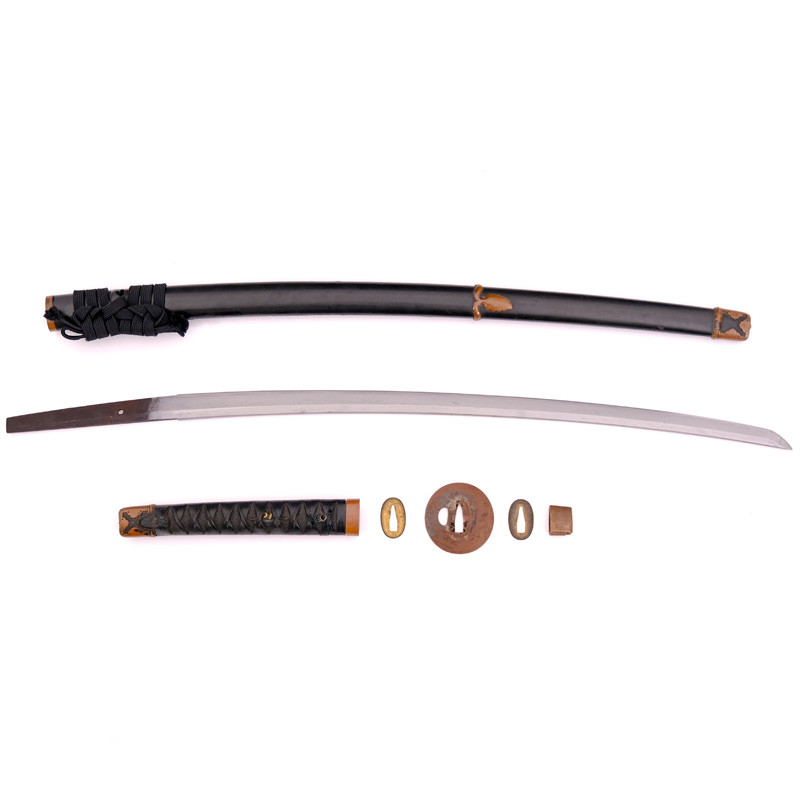Tsuka
&
Tosogu
(Tsuba,
Menuki,
Fuchi Kashira) |
- Tsuka: Length of 24.3cm weight of 132g. Same black, braiding Tsumami maki old patina black silk almost lacquered,
- Menuki : Basket design Shakudo with golden flowers and millet ears
- Tsuba : Maru Gata shape with Kaku border Migi Gata, 1 Kozuka Hana
- Fuchi Kashira: Kabuto Gane, copper in suite with Tsuba and Saya parts (Handachi assembly)
- Habaki: 23g Muji copper
- Seppa: 2 gold copper seppa for a total weight of 8g |
Study
&
Team Review |
This blade from the Naminohira school 波平 of Satsuma 薩摩 is with a hada of the Ayasugi type hada 綾杉肌 lineage Oshu Gassan 奥州月山. Oshu, also known as Mutsu, is an ancient province of northern Honshu, today comprising Iwate, Aomori, Fukushima and Miyagi.
The Hada Ayasugi, wave-shaped hada, existed in ancient times in the Yamato tradition (Heian period 794 – 1185). This technique is then used in two geographically opposite regions of Japan.
The Ayasugi hada is therefore found during the Muromachi era (1333-1573) in Oshu (North Honshu), where Mount Gassan is located, but also at Naminohira in Satsuma (Kyushu). This type of Hada then disappeared during the Edo era.
This Hamon is most often assimilated to the lineage of blacksmiths Gassan. Mount Gassan, in Tohoku, was a very popular place of pilgrimage because Gassan 月 山 refers to the deity of the moon (月) Tsukuyomi (月読) who, in Japanese mythology, was born from the eye of Izanagi and was one of the brothers of the sun goddess Amaterasu 天照.
This blade confirms, or at least goes in the direction of a theory of the researcher Kunio Yanagita 柳田 國男, founder of folklore ethnology in Japan, how the spread of Japanese techniques and traditions appear from inner regions then disappear from them, to finally be found by transmission in outer peripheral regions.
« 物の伝播は中央より起こり長い間に中央では消え去り辺境でその伝統は残る »
Naminohira was one of the most influential forging schools in the Satsuma domain. This school was founded by Masakuni 正國, blacksmith of the Yamato tradition (Nara region), during the end of the Heian period (late 12th century). Most of the productions of this school have therefore characteristics of the Yamato tradition.
The Satsuma domain was ruled by the Shimazu 島津 clan, descendants of Emperor Seiwa and Shogun Minamoto No Yoritomo. The Shimazu clan was a clan of feared fighters, especially during the Sengoku period. Since the time of Kamakura, the Shimazu have been appointed ‘Shugo’, official provincial governor, in charge of maintaining order and law.
This powerful clan decided to unify all of Kyushu, which he started with determination and success, but he attracted the mistrust of Toyotomi Hideyoshi. The latter then decided to invade Kyushu where he met a stubborn opponent, Yoshihiro Shimazu (1535-1619), who later became one of his generals. Yoshihiro Shimazu distinguished himself in many battles, including naval battles against the Sino-Korean naval army. He and his well-trained troops were nicknamed ‘Oni Shimazu’, ‘The demons of Shimazu’.
The name Naminohira would come from a legend that Masakuni, the founder, was able to calm the waves by dedicating his blades to the ocean.
The name Naminohira is composed of the kanji of wave ‘波’ and flat ‘平’, which could be translated into extrapolating “Sailing on calm seas”. These were highly valued blades in the Imperial Japanese Naval Army, as a sign of good omen.
In general, the blades of the Naminohira tradition are rare and valuable to collect.
|
















Share your opinion
error Your review appreciation cannot be sent
feedback Report comment
check_circle Report sent
error Your report cannot be sent